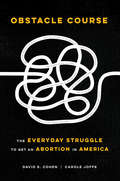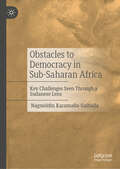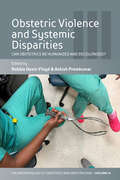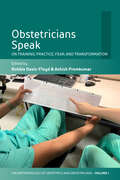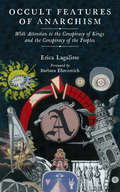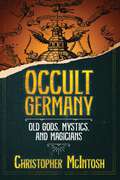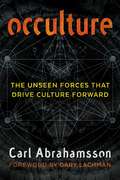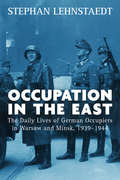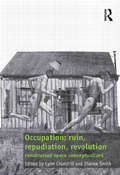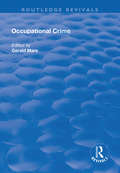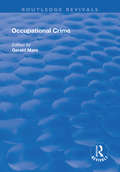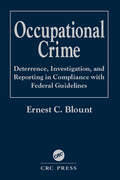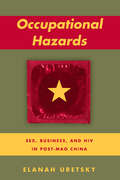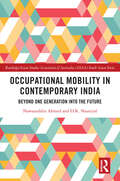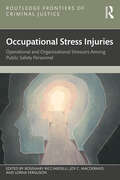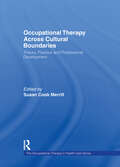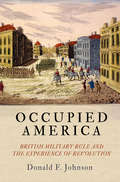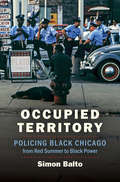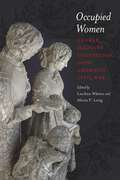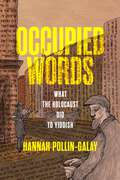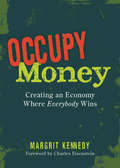- Table View
- List View
Obstacle Course: The Everyday Struggle to Get an Abortion in America
by Carole Joffe David S. CohenIt seems unthinkable that citizens of one of the most powerful nations in the world must risk their lives and livelihoods in the search for access to necessary health care. And yet it is no surprise that in many places throughout the United States, getting an abortion can be a monumental challenge. Anti-choice politicians and activists have worked tirelessly to impose needless restrictions on this straightforward medical procedure that, at best, delay it and, at worst, create medical risks and deny women their constitutionally protected right to choose. Obstacle Course tells the story of abortion in America, capturing a disturbing reality of insurmountable barriers people face when trying to exercise their legal rights to medical services. Authors David S. Cohen and Carole Joffe lay bare the often arduous and unnecessarily burdensome process of terminating a pregnancy: the sabotaged decision-making, clinics in remote locations, insurance bans, harassing protesters, forced ultrasounds and dishonest medical information, arbitrary waiting periods, and unjustified procedure limitations. Based on patients’ stories as well as interviews with abortion providers and allies from every state in the country, Obstacle Course reveals the unstoppable determination required of women in the pursuit of reproductive autonomy as well as the incredible commitment of abortion providers. Without the efforts of an unheralded army of medical professionals, clinic administrators, counselors, activists, and volunteers, what is a legal right would be meaningless for the almost one million people per year who get abortions. There is a better way—treating abortion like any other form of health care—but the United States is a long way from that ideal.
Obstacles to Democracy in Sub-Saharan Africa: Key Challenges Seen Through a Sudanese Lens
by Nagmeldin Karamalla-GaiballaThis book analyses the failure factors of democratic experiences in Sub-Saharan Africa, focusing on the Republic of Sudan. Through historical comparisons, it aims to further our understanding of democratic African state formation in the aftermath of colonialism, the impact of military coups on undermining democracy in sub-Saharan Africa, the formation and structuring of political parties in the region, and the failures and successes of popular revolutions in establishing good governance. To do so, the author weaves a portrait of the current state of democratic governance in Sudan and the broader sub-Saharan region by threading primary data analysis, such as expert interviews and surveyed participants of the Sudanese revolution, along with their personal reflections and observations on life lived in Sudan. Arguing that the nation is in a state of political crisis, the book posits that Sudan marks a potent example of failing democratic institutions in sub-Saharan Africa in the post-colonial era.
Obstetric Violence and Systemic Disparities: Can Obstetrics Be Humanized and Decolonized? (The Anthropology of Obstetrics and Obstetricians: The Practice, Maintenance, and Reproduction of a Biomedical Profession #3)
by Robbie Davis-Floyd and Ashish PremkumarThe final volume in this landmark 3-volume series The Anthropology of Obstetrics and Obstetricians: The Practice, Maintenance, and Reproduction of a Biomedical Profession looks at the challenges, and even violence, that obstetricians face across the world. Part I of this volume addresses obstetric violence and systemic racial, ethnic, gendered, and socio-structural disparities in obstetricians’ practices in the Dominican Republic, Mexico, Peru, and the US. Part II addresses decolonizing and humanizing obstetric training and practice in the UK, Russia, Brazil, New Zealand, and the US. Part 3 presents the ethnographic challenges that the chapter authors in Volumes II and III of this series faced in finding, surveying, interviewing, and observing obstetricians in various countries. This book is a must-read for students, social scientists, and all maternity care practitioners who seek to understand the diverse challenges that obstetricians must overcome. An excerpt: In our Series Overview in Volume 1, we asked the question, “Can a book create a field?” and answered that question with a resounding “Yes!” … For us, the official creation of the field of the Anthropology of Obstetrics and Obstetricians has taken not one, but the 3 volumes that constitute this Book Series.
Obstetricians Speak: On Training, Practice, Fear, and Transformation (The Anthropology of Obstetrics and Obstetricians: The Practice, Maintenance, and Reproduction of a Biomedical Profession #1)
by Robbie Davis-Floyd and Ashish PremkumarFor the first time ever in a social science work, obstetricians tell their own stories of training, practice, fear, and transformation in this the first of the 3-volume series The Anthropology of Obstetrics and Obstetricians: The Practice, Maintenance, and Reproduction of a Biomedical Profession. These stories range from those of abortion providers to those of maternal-fetal medicine specialists. Several chapters tell the stories of obstetricians who have made paradigm shifts from technocratic to humanistic practices, the benefits and joys of these paradigm shifts, and the ostracism, bullying, and outright persecution these humanistic obstetricians have suffered. This book is a must-read for students, social scientists, and all maternity care practitioners who seek to understand the ideologies and motives of individual obstetricians. An excerpt from Kathleen Hanlon-Lundberg’s chapter: Largely maligned in reproductive anthropological literature as callous—if not brutal—self-serving effectors of the over-medicalization of childbirth, most obstetricians whom I know and have worked with are devoted to providing respectful, individualized care to their patients.
Obstetrics and Gynecology in Low-Resource Settings
by Nawal M. NourObstetrics and Gynecology in Low-Resource Settings provides practical guidelines for ensuring quality care to women in locations where facilities are inadequate, equipment and medications are in short supply, and medical staff are few. This reference will be an essential companion to health care providers throughout the world.
Obstinate Hebrews: Representations of Jews in France, 1715-1815
by Ronald SchechterA path-breaking study of the Jews in France from the time of the philosophies through the Revolution and up to Napoleon. Examines how Jews were thought of during this time, by both French writers and the Jews themselves.
Occult Features of Anarchism: With Attention to the Conspiracy of Kings and the Conspiracy of the Peoples (KAIROS)
by Barbara Ehrenreich Erica LagalisseIn the nineteenth century anarchists were accused of conspiracy by governments afraid of revolution, but in the current century various "conspiracy theories" suggest that anarchists are controlled by government itself. The Illuminati were a network of intellectuals who argued for self-government and against private property, yet the public is now often told that they were (and are) the very group that controls governments and defends private property around the world. Intervening in such misinformation, Lagalisse works with primary and secondary sources in multiple languages to set straight the history of the Left and illustrate the actual relationship between revolutionism, pantheistic occult philosophy, and the clandestine fraternity. Exploring hidden correspondences between anarchism, Renaissance magic, and New Age movements, Lagalisse also advances critical scholarship regarding leftist attachments to secular politics. Inspired by anthropological fieldwork within today's anarchist movements, her essay challenges anarchist atheism insofar as it poses practical challenges for coalition politics in today's world. Studying anarchism as a historical object, Occult Features of Anarchism also shows how the development of leftist theory and practice within clandestine masculine public spheres continues to inform contemporary anarchist understandings of the "political," in which men's oppression by the state becomes the prototype for power in general. Readers behold how gender and religion become privatized in radical counterculture, a historical process intimately linked to the privatization of gender and religion by the modern nation-state.
Occult Germany: Old Gods, Mystics, and Magicians
by Christopher McIntosh• Examines the survival and revival of the old pre-Christian gods, investigates prehistoric sacred sites, and reveals ancient shamanic traditions • Looks at Rosicrucianism and the distinctive Germanic forms of astrology, alchemy, and the Kabbalah • Discusses German poets, philosophers, and mystics, such as Dr. Johann Faust, Wolfram von Eschenbach, Meister Eckhart, Hildegard of Bingen, and Jakob Boehme No country is richer in occult and esoteric traditions than Germany. In this magical journey through the inner history of Deutschland, Christopher McIntosh explores many of these traditions from prehistory to the 21st century. Recounting the longstanding magical tradition of Germany, McIntosh investigates the numerous prehistoric sacred sites that point to a nearly-forgotten ancient shamanic civilization. He examines the survival and revival of the old pre-Christian gods in folklore, customs, and practices as well as witchcraft. He looks at Germany&’s rich and many-faceted spiritual heritage and explores Christian mysticism and theosophy as exemplified by Meister Eckhart, Hildegard of Bingen, and Jakob Boehme. Examining Rosicrucianism, which originated in Germany, the author also looks at other secret societies that flourished in Germany such as speculative Freemasonry, the Fraternitas Saturni, and the Golden and Rosy Cross. He explores how the Church sought to stamp out the old gods and pagan beliefs, as well as how periods of the Church&’s heaviest oppression produced immortal poets, philosophers, theologians, artists, and mystics. He examines the distinctive forms adopted by astrology, alchemy, and the Kabbalah in Germany as well as the esoteric influences on Romanticism. Exploring more recent centuries, the author looks at the Nordic revival in the 19th century and the influence of Theosophy and the movements that grew out of it, such as Steiner&’s Anthroposophy. Examining the esoteric traditions of the 20th century, he looks at the work of neo-Nordic occultists and esoteric writers like Meyrink and Hesse. He explores certain occult aspects of the Third Reich, which resulted in a backlash against the occult. He also looks at modern occult practices and the rise of neopaganism. Revealing both the enlightened and the dark sides of occult Germany, the author shows how this country has long been a cauldron in which esoteric ideas have flourished, spread, been condemned, and lauded, leaving an enduring mark.
Occulture: The Unseen Forces That Drive Culture Forward
by Gary Lachman Carl AbrahamssonExplores the role of magic and the occult in art and culture from ancient times to today • Examines key figures behind esoteric cultural developments, such as Carl Jung, Anton LaVey, Paul Bowles, Aleister Crowley, and Rudolf Steiner • Explores the history of magic as a source of genuine counter culture and compares it with our contemporary soulless, digital monoculture • Reveals how the magic of art can be restored if art is employed as a means rather than an end and offers strategies to rekindle intuitive creativity Art, magic, and the occult have been intimately linked since our prehistoric ancestors created the first cave paintings some 50,000 years ago. As civilizations developed, these esoteric forces continued to drive culture forward, both visibly and behind the scenes, from the Hermetic ideas of the Renaissance, to the ethereal worlds of 19th century Symbolism, to the occult interests of the Surrealists. In this deep exploration of “occulture”--the liminal space where art and magic meet--Carl Abrahamsson reveals the integral role played by magic and occultism in the development of culture throughout history as well as their relevance to the continuing survival of art and creativity. Blending magical history and esoteric philosophy with his more than 30 years’ experience in occult movements, Abrahamsson looks at the phenomena and people who have been seminal in modern esoteric developments, including Carl Jung, Anton LaVey, Paul Bowles, Aleister Crowley, and Rudolf Steiner. Showing how art and magic were initially one and the same, the author explores the history of magic as a source of genuine counter culture and compares it with our contemporary soulless, digital monoculture. He reveals how the magic of art can be restored if art is employed as a means rather than an end--if it is intense, emotional, violent, and expressive--and offers strategies for creating freely, magically, even spontaneously, with intent unfettered by the whims of trends, a creative practice akin to chaos magick that assists both creators and spectators to live with meaning. He also looks at intuition and creativity as the cornerstones of genuine individuation, explaining how insights and illuminations seldom come in collective forms. Exploring magical philosophy, occult history, the arts, psychology, and the colorful grey areas in between, Abrahamsson reveals the culturally and magically transformative role of art and the ways the occult continues to transform culture to this day.
Occupation Diaries
by Raja ShehadehIt is often the smallest details of daily life that tell us the most. And so it is under occupation in Palestine. What most of us take for granted has to be carefully thought about and planned for: When will the post be allowed to get through? Will there be enough water for the bath tonight? How shall I get rid of the rubbish collecting outside? How much time should I allow for the journey to visit my cousin, going through checkpoints? And big questions too: Is working with left-wing Israelis collaborating or not? What affect will the Arab Spring have on the future of Palestine? What can anyone do to bring about change? Are any of life's pleasures untouched by politics?
Occupation in the East: The Daily Lives of German Occupiers in Warsaw and Minsk, 1939-1944
by Stephan LehnstaedtFollowing their occupation by the Third Reich, Warsaw and Minsk became home to tens of thousands of Germans. In this exhaustive study, Stephan Lehnstaedt provides a nuanced, eye-opening portrait of the lives of these men and women, who constituted a surprisingly diverse population—including everyone from SS officers to civil servants, as well as ethnically German city residents—united in its self-conception as a “master race.” Even as they acclimated to the daily routines and tedium of life in the East, many Germans engaged in acts of shocking brutality against Poles, Belarusians, and Jews, while social conditions became increasingly conducive to systematic mass murder.
Occupation: constructed space conceptualized
by Dianne Smith Lynn ChurchillBringing together an international range of contributors from the fields of practice, theory and history, this book takes a fresh look at occupation. It argues that occupation is a prospect that begins with ruin--a residue from the past, an implied or even a resounding presence of something previous that holds the potential for transformation. This prospect invites us to repudiate, re-imagine and re-define lived space, thereby asserting occupation as an act of revolution. Authors drawn from the fields of architecture, urbanism, interior architecture, dance dramaturgy, art history, design and visual arts, cultural studies and media studies provide a unique, holistic view of occupation, examining topics such as: the authority of architecture; architecture as an act of revolution; women in hypersexual space; occupation as a serialized act of ruin; and the definition of space as repudiation. They discuss how acts that re-invent territory and/or shift boundaries--psychological, social and physical--affect identity and demonstrate possession. This theme of occupation is significant and topical at a time of radical flux, generated by the proliferation of hypermedia, and also by the dramatically shifting environmental, political and economic context of this era. The book concludes by asserting that it is through occupation (private and public: real, virtual, remembered, re-invented) that we appear or disappear as the individual or collective self, because the spaces we construct assert particular agendas which we may either contest or live in accord with.
Occupational Crime
by Gerald MarsThis title was first publishde in 2001. Occupational crime is found in the whole range of occupations and at all levels. Despite the fact that activities are widespread and well known, the area is blurred by contradictory perceptions, denials and arguments over definition. This volume presents influential essays on the topic.
Occupational Crime
by Gerald MarsThis title was first publishde in 2001. Occupational crime is found in the whole range of occupations and at all levels. Despite the fact that activities are widespread and well known, the area is blurred by contradictory perceptions, denials and arguments over definition. This volume presents influential essays on the topic.
Occupational Crime: Deterrence, Investigation, and Reporting in Compliance with Federal Guidelines
by Ernest C. BlountDID YOU KNOW? While organizational entities cannot be sent to prison, they can be heavily fined, ordered to make restitution, placed on probation, forced to forfeit property, suffer public and stakeholder recriminations, and can be forced out of business. Avoid these unnecessary repercussions with Occupational Crime: Deterrence, Investigatio
Occupational Hazards
by Elanah UretskyDoing business in China can be hazardous to your health. Occupational Hazards follows a group of Chinese businessmen and government officials as they conduct business in Beijing and western Yunnan Province, exposing webs of informal networks that help businessmen access political favors. These networks are built over liquor, cigarettes, food, and sex, turning risky behaviors into occupational hazards. Elanah Uretsky's ethnography follows these powerful men and their vulnerabilities to China's burgeoning epidemics of sexually transmitted infections (STIs) and HIV/AIDS. Examining the relationship between elite masculine networking practices and vulnerability to HIV infection, Occupational Hazards includes the stories of countless government officials and businessmen who regularly visit commercial sex workers but resist HIV testing for fear of threatening their economic and political status. Their fate is further complicated by a political system that cannot publicly acknowledge such risk and by authoritative international paradigms that limit the reach of public health interventions. Ultimately, Uretsky offers insights into how complex socio-cultural and politico-economic negotiations affect the development and administration of China's HIV epidemic.
Occupational Mobility in Contemporary India: Beyond One Generation Into the Future (Routledge / Asian Studies Association of Australia (ASAA) South Asian Series)
by D.K. Nauriyal Nawazuddin AhmedThis book analyses the magnitude of the relationship between family background and adult occupational and educational outcomes and provides a comprehensive view of intergenerational mobility in the context of religious and caste dynamics in India. Based on nationally representative data sets, the book tracks educational and occupational mobility experiences of different socio-religious groups in contemporary India. Examining primary and secondary data to comprehend the macro picture and the micro details, the book offers insights into intra-generational occupational mobility and the perceptions and expectations of Muslim households. The book presents a classification of jobs and mobility analysis that is built on solid foundations of stratification theories. Moreover, it identifies data and presents evidence on the neighborhood effects in India. Offering an analysis of intergenerational advancement, this book is aimed at researchers in the field of economics, sociology, labor studies, development studies, minority and subaltern studies as well as those interested in the socio-economic issues of disadvantaged socio-religious groups in India.
Occupational Stress Injuries: Operational and Organizational Stressors Among Public Safety Personnel (Routledge Frontiers of Criminal Justice)
by Rosemary Ricciardelli Lorna Ferguson Joy C. MacDermidThis book explores the stress faced by public safety professionals across an array of occupational fields, such as police, correctional officers, paramedics, and firefighters.Bringing together leading scholars from around the world, it showcases cutting-edge quantitative and qualitative research from across three continents and multiple regions within six countries, introduces key concepts related to occupational and organizational stressors, and provides an overview of the state of current research in key topic areas. Those who have yet to be exposed to the concepts associated with occupational stress injuries, or to the range of theories and methodologies, will be provided with an informative introduction to this topic. It explores the state of current literature on this topic, identifies gaps in our knowledge and approaches to understanding the relationship between occupational stressors and different outcomes, and provides potential responses for reducing or ameliorating occupational stressors experienced by public safety personnel.Aimed at students, academic researchers, public safety practitioners, law enforcement analysts, and public policy-makers, this book will appeal to readers who have some knowledge in this area and are interested in learning more about new and emerging research, as well as those who are well-versed on this topic.
Occupational Therapy Across Cultural Boundaries: Theory, Practice and Professional Development
by Susan Cook MerrillThis fascinating book examines the concept of culture from a unique perspective--that of individual occupational therapists who have worked in environments very different from those in which they were educated or had worked previously. In Occupational Therapy Across Cultural Boundaries, six occupational therapists relate their experiences living and working in a foreign culture. Each author describes the daily demands placed upon her through immersion into a different way of life and discusses the environmental challenges she had to overcome to be able to live and work successfully. Many of the cultural differences the authors faced forced them to reassess and reconstruct their most basic assumptions of both personal and professional life as they discovered that activities and theories common or applicable in one culture are not necessarily translatable into another. The authors also analyze culture across treatment areas in occupational therapy practice, including mental health and physical disability, with both adults and children.Both beginning and experienced occupational therapists and occupational therapy students will find much valuable information in Occupational Therapy Across Cultural Boundaries. Whether interested in examining occupational therapy’s application to non-Western cultures, or actually contemplating practicing in a different culture, readers will benefit from learning about the experiences of the authors. This unique book is also helpful for occupational therapy students wishing to examine the philosophy of occupational therapy or the significance of culture to human occupation. Professors will find it useful as an ancillary textbook for undergraduate and graduate courses in occupational therapy on topics such as theory, occupation across cultures, or meaningful activity.
Occupational Therapy in Australia: Professional and practice issues
by Ted Brown Reinie Cordier Helen Bourke-Taylor Stephen IsbelThis ground-breaking text provides a comprehensive guide to occupational therapy in Australia, from its role in the healthcare system to the scope and nature of its practice. The authors begin with an overview of the history of occupational therapy in Australia, the ethical and legal aspects of its practice and its role in population health and health promotion. The values and philosophy of occupational therapy are considered next, together with the roles and responsibilities of practitioners and specific practice features, including client-centred practice, evidence-based practice, research in occupational therapy and clinical reasoning. Key issues, including occupational analysis, the development of occupations across the lifespan, occupational therapy assessment, Indigenous issues, practice in rural and remote areas and advocacy, leadership and entrepreneurship, are also examined in detail.The first text specifically written for Australian entry-to-practice students by Australian authors, this book is destined to become an essential reference for both students and professionals in the field.'Truly a valuable resource for all Australian occupational therapy students and practitioners.'Professor Jenny Ziviani, Children's Allied Health Research, The University of Queensland'This is a text that will have many editions and document the evolution of the profession for decades to come.'Professor Carolyn M. Baum, School of Medicine, Washington University in St. Louis
Occupied America: British Military Rule and the Experience of Revolution (Early American Studies)
by Donald F. JohnsonOccupied America chronicles the everyday experience of ordinary people living under military occupation during the American Revolution.In Occupied America, Donald F. Johnson chronicles the everyday experience of ordinary people living under military occupation during the American Revolution. Focusing on day-to-day life in port cities held by the British Army, Johnson recounts how men and women from a variety of backgrounds navigated harsh conditions, mitigated threats to their families and livelihoods, took advantage of new opportunities, and balanced precariously between revolutionary and royal attempts to secure their allegiance.Between 1775 and 1783, every large port city along the Eastern seaboard fell under British rule at one time or another. As centers of population and commerce, these cities—Boston, New York, Newport, Philadelphia, Savannah, Charleston—should have been bastions from which the empire could restore order and inspire loyalty. Military rule's exceptional social atmosphere initially did provide opportunities for many people—especially women and the enslaved, but also free men both rich and poor—to reinvent their lives, and while these opportunities came with risks, the hope of social betterment inspired thousands to embrace military rule. Nevertheless, as Johnson demonstrates, occupation failed to bring about a restoration of imperial authority, as harsh material circumstances forced even the most loyal subjects to turn to illicit means to feed and shelter themselves, while many maintained ties to rebel camps for the same reasons. As occupations dragged on, most residents no longer viewed restored royal rule as a viable option.As Johnson argues, the experiences of these citizens reveal that the process of political change during the Revolution occurred not in a single instant but gradually, over the course of years of hardship under military rule that forced Americans to grapple with their allegiance in intensely personal and highly contingent ways. Thus, according to Johnson, the quotidian experience of military occupation directly affected the outcome of the American Revolution.
Occupied Territory: Policing Black Chicago from Red Summer to Black Power (Justice, Power, and Politics)
by Simon BaltoIn July 1919, an explosive race riot forever changed Chicago. For years, black southerners had been leaving the South as part of the Great Migration. Their arrival in Chicago drew the ire and scorn of many local whites, including members of the city's political leadership and police department, who generally sympathized with white Chicagoans and viewed black migrants as a problem population. During Chicago's Red Summer riot, patterns of extraordinary brutality, negligence, and discriminatory policing emerged to shocking effect. Those patterns shifted in subsequent decades, but the overall realities of a racially discriminatory police system persisted.In this history of Chicago from 1919 to the rise and fall of Black Power in the 1960s and 1970s, Simon Balto narrates the evolution of racially repressive policing in black neighborhoods as well as how black citizen-activists challenged that repression. Balto demonstrates that punitive practices by and inadequate protection from the police were central to black Chicagoans' lives long before the late-century "wars" on crime and drugs. By exploring the deeper origins of this toxic system, Balto reveals how modern mass incarceration, built upon racialized police practices, emerged as a fully formed machine of profoundly antiblack subjugation.
Occupied Women: Gender, Military Occupation, and the American Civil War
by Alecia P. Long Leeann WhitesIn the spring of 1861, tens of thousands of young men formed military companies and offered to fight for their country. Near the end of the Civil War, nearly half of the adult male population of the North and a staggering 90 percent of eligible white males in the South had joined the military. With their husbands, sons, and fathers away, legions of women took on additional duties formerly handled by males, and many also faced the ordeal of having their homes occupied by enemy troops. With occupation, the home front and the battlefield merged to create an unanticipated second front where civilians-mainly women-resisted what they perceived as unjust domination. In Occupied Women, twelve distinguished historians consider how women's reactions to occupation affected both the strategies of military leaders and ultimately even the outcome of the Civil War. Alecia P. Long, Lisa Tendrich Frank, E. Susan Barber, and Charles F. Ritter explore occupation as an incubator of military policies that reflected occupied women's activism. Margaret Creighton, Kristen L. Streater, LeeAnn Whites, and Cita Cook examine specific locations where citizens both enforced and evaded these military policies. Leslie A. Schwalm, Victoria E. Bynum, and Joan E. Cashin look at the occupation as part of complex and overlapping differences in race, class, and culture. An epilogue by Judith Giesberg emphasizes these themes. Some essays reinterpret legendary encounters between military men and occupied women, such as those prompted by General Butler's infamous "Woman Order" and Sherman's March to the Sea. Others explore new areas such as the development of military policy with regard to sexual justice. Throughout, the contributors examine the common experiences of occupied women and address the unique situations faced by women, whether Union, Confederate, or freed. Civil War historians have traditionally depicted Confederate women as rendered inert by occupying armies, but these essays demonstrate that women came together to form a strong, localized resistance to military invasion. Guerrilla activity, for example, occurred with the support and active participation of women on the home front. Women ran the domestic supply line of food, shelter, and information that proved critical to guerrilla tactics. By broadening the discussion of the Civil War to include what LeeAnn Whites calls the "relational field of battle," this pioneering collection helps reconfigure the location of conflict and the chronology of the American Civil War.
Occupied Words: What the Holocaust Did to Yiddish (Jewish Culture and Contexts)
by Hannah Pollin-GalayHow Yiddish changed to express and memorialize the trauma of the HolocaustThe Holocaust radically altered the way many East European Jews spoke Yiddish. Finding prewar language incapable of describing the imprisonment, death, and dehumanization of the Shoah, prisoners added or reinvented thousands of Yiddish words and phrases to describe their new reality. These crass, witty, and sometimes beautiful Yiddish words – Khurbn Yiddish, or “Yiddish of the Holocaust” – puzzled and intrigued the East European Jews who were experiencing the metamorphosis of their own tongue in real time. Sensing that Khurbn Yiddish words harbored profound truths about what Jews endured during the Holocaust, some Yiddish speakers threw themselves into compiling dictionaries and glossaries to document and analyze these new words. Others incorporated Khurbn Yiddish into their poetry and prose. In Occupied Words, Hannah Pollin-Galay explores Khurbn Yiddish as a form of Holocaust memory and as a testament to the sensation of speech under genocidal conditions. Occupied Words investigates Khurbn Yiddish through the lenses of cultural history, philology, and literary interpretation. Analyzing fragments of language consciousness left behind from the camps and ghettos alongside the postwar journeys of three intellectuals—Nachman Blumental, Israel Kaplan and Elye Spivak—Pollin-Galay seeks to understand why people chose Yiddish lexicography as a means of witnessing the Holocaust. She then turns to the Khurbn Yiddish words themselves, focusing on terms related to theft, the German-Yiddish encounter and the erotic female body. Here, the author unearths new perspectives on how Jews experienced daily life under Nazi occupation, while raising questions about language and victimhood. Lastly, the book explores how writers turned ghetto and camp slang into art—highlighting the poetry and fiction of K. Tzetnik (Yehiel Di-Nur) and Chava Rosenfarb. Ultimately, Occupied Words speaks to broader debates about cultural genocide, asking how we might rethink the concept of genocide through the framework of language.
Occupy Money: Creating an Economy Where Everybody Wins
by Margrit KennedyA visionary case for a new monetary system that is interest-free, just and stableAs a medium of exchange, money is one of the most ingenious inventions of mankind, as it facilitates the trade of goods and services and allows for specialization and the division of labor. However, compound interest and inflation have caused our monetary system to balloon to the point where bailing out banks, large corporations, and even entire countries will not prevent a complete breakdown of the global economy-unless we change the system in fundamental ways.It's time for a grassroots movement to knock conventional money off its pedestal and replace it with a fresh paradigm that puts people before profits. A guide not only for the 99% but also for the 1%, Occupy Money demonstrates that the creation of a stable and sustainable monetary system will reflect real wealth rather than the smoke and mirrors of speculative profit, thus providing an alternative to the Age of Austerity. This vision can be realized through such creative initiatives as:Establishing time banks and complementary currencies geared to specific services such as health and educationEliminating interest through interest-free loans and "demurrage", which rewards currency circulationRe-localizing economies through regional currencies.For many years financial insiders have hidden economic truths by describing them in arcane terms that no layperson can understand. Occupy Money uses clear, simple and concise language to explain how money will serve people instead of people serving money, and in doing so it issues a challenge to the very foundations of conventional economic doctrine.
